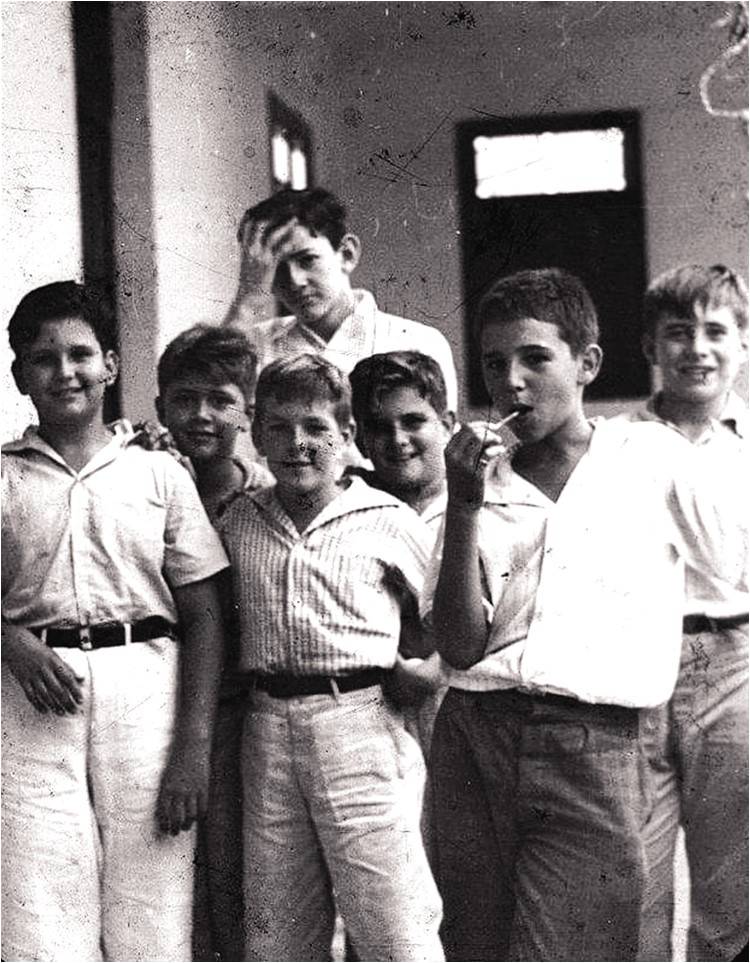
This photograph shows young Fidel Castro eating a lollipop with his schoolmates at Nuestra Senora de Dolores school in Santiago, Cuba, 1937. It was captured by José María.
Fidel Castro Ruz was born on August 13, 1926, on his family’s successful sugar plantation near Birán, in Cuba. Castro’s parents had not planned to send their young son to school, but he was so set on getting an education that he talked them into letting him go when he was only six or seven years old. Castro studied in Jesuit schools in Oriente and in Havana, Cuba. He was a motivated student who did well in agriculture, history, and Spanish, and he was also an exceptional athlete. Meanwhile, he showed little interest in socialising.
In 1945, Castro entered law school at the University of Havana, where student activism, violence, and gang fights were common. Castro soon joined the activists and associated with one of the gangs, the Unión Insurreccional Revolucionaria. Although police suspected him of the murder of a rival student leader and other violent actions, nothing was proven. Castro developed a reputation for his personal ambition and public speaking ability, yet he never became a well-known student leader. On several occasions he was defeated in student elections.
In 1947, Castro temporarily left university in order to join an expedition led by writer Juan Bosch to overthrow the government of Dominican dictator Rafael Trujillo (1891–1961). The coup was called off during the ocean voyage to Dominica. The following year Castro participated in one of the most controversial episodes of his life: the Bogotazo, a series of riots in Bogotá, Colombia, following the assassination of Liberal party leader Jorge E. Gaitán (1902–1948). He joined the mobs and roamed the streets, distributing anti-United States material and stirring a revolt. Pursued by Colombian authorities, the Cuban students sought asylum, or protection, in the Cuban embassy. Afterwards, Castro flew back to Havana and resumed his law studies.
At the university Castro was exposed to various ideologies. The ideas of fascism and communism were widely discussed. Castro soon found a calling with Cuba’s Ortodoxo party, which stressed economic independence, political liberty, social justice, and an end to corruption. Castro also became a devoted follower of the party’s charismatic leader, Eduardo Chibás.
While still a student, Castro married Mirta Díaz-Balart, a philosophy student whose wealthy family had political ties to powerful Cuban military leader Fulgencio Batista (1901–1973). The couple had one son, Fidelito, in 1949. Because Castro had no income with which to support his family, the marriage eventually ended.
Fidel Castro Ruz was born on August 13, 1926, on his family’s successful sugar plantation near Birán, in Cuba. Castro’s parents had not planned to send their young son to school, but he was so set on getting an education that he talked them into letting him go when he was only six or seven years old. Castro studied in Jesuit schools in Oriente and in Havana, Cuba. He was a motivated student who did well in agriculture, history, and Spanish, and he was also an exceptional athlete. Meanwhile, he showed little interest in socialising.
In 1945, Castro entered law school at the University of Havana, where student activism, violence, and gang fights were common. Castro soon joined the activists and associated with one of the gangs, the Unión Insurreccional Revolucionaria. Although police suspected him of the murder of a rival student leader and other violent actions, nothing was proven. Castro developed a reputation for his personal ambition and public speaking ability, yet he never became a well-known student leader. On several occasions he was defeated in student elections.
In 1947, Castro temporarily left university in order to join an expedition led by writer Juan Bosch to overthrow the government of Dominican dictator Rafael Trujillo (1891–1961). The coup was called off during the ocean voyage to Dominica. The following year Castro participated in one of the most controversial episodes of his life: the Bogotazo, a series of riots in Bogotá, Colombia, following the assassination of Liberal party leader Jorge E. Gaitán (1902–1948). He joined the mobs and roamed the streets, distributing anti-United States material and stirring a revolt. Pursued by Colombian authorities, the Cuban students sought asylum, or protection, in the Cuban embassy. Afterwards, Castro flew back to Havana and resumed his law studies.
At the university Castro was exposed to various ideologies. The ideas of fascism and communism were widely discussed. Castro soon found a calling with Cuba’s Ortodoxo party, which stressed economic independence, political liberty, social justice, and an end to corruption. Castro also became a devoted follower of the party’s charismatic leader, Eduardo Chibás.
While still a student, Castro married Mirta Díaz-Balart, a philosophy student whose wealthy family had political ties to powerful Cuban military leader Fulgencio Batista (1901–1973). The couple had one son, Fidelito, in 1949. Because Castro had no income with which to support his family, the marriage eventually ended.

